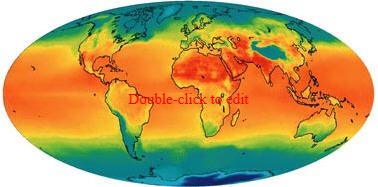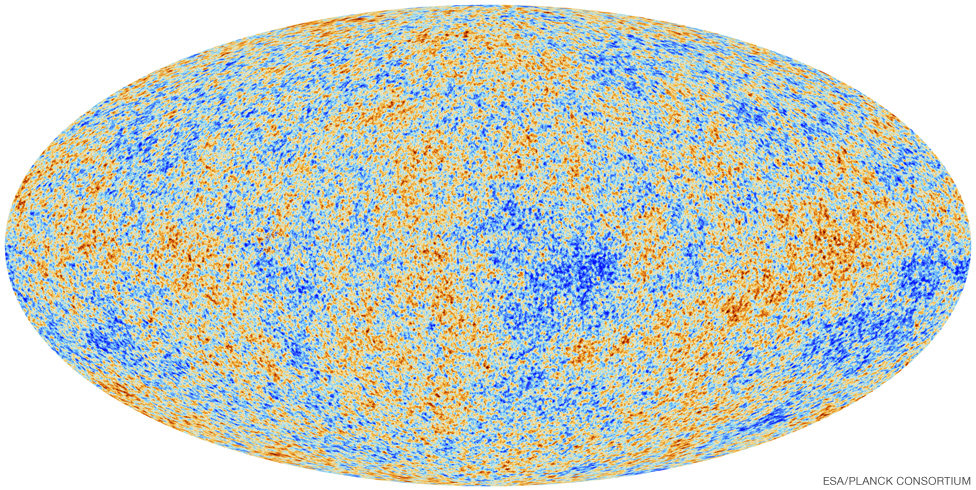The First Light Has Fluctuations
Several groups of astrophysicists have resolved the density fluctuations in the cosmic background into clusters of bright circular spots. The spots are a few tens of microkelvins warmer than their surroundings. The average warm spot is about a degree of arc in diameter, twice the apparent size of the Sun or Moon. What we now call the cosmic background was originally bright reddish light at about 3000 kelvins, but now its temperature is less than three kelvins. Therefore the spots were originally a few tens of millikelvins warmer than their surroundings. The difference in temperature was too small to make them noticeably brighter if anyone had been present to look, but the color difference might have been perceptible.
Researchers often display their results with false color photographs that bring out the small differences in temperature. In these photographs the spots look like stars. The spots are not stars as astronomers now define the word.
People often use the same word for objects that specialists distinguish. When people see bright, compact sky objects they usually call them “stars,” but astronomers classify them as stars, planets, comets, and meteors. The warm spots soon after the beginning are yet another class in their terminology. We can show the photographs to modern children, and if we don’t prompt them, they are likely to call the spots stars. If we could show the photographs to people of previous millennia, they would probably call the spots “stars” in their own ancient language.
The objects astronomers call stars began to shine long after the light of the first morning faded, along with its warm spots. Yet we would be justified in calling the spots “the morning stars.” They appeared at the end of the first morning when atoms, the foundations of the Earth and everything else, had just formed for the first time.
While we wait for theoreticians to address the questions we mentioned previously about inflation and the causality discrepancy, we can appreciate an interesting point that will remain valid whatever the age of the first light turns out to be. There are enough spots to gather statistics on their properties. The diameters of the spots follow a distribution with several peaks and valleys, like a wave. Physicists have shown that the distribution arises because of acoustic resonance.[i] Resonance means that waves of certain wavelengths fit together and reinforce each other. When analyzing the diameters of the warm spots, they are talking about the resonance of sound waves inside a sphere.
[i] Schwarzschild, Bertram, “Cosmic Microwave Observations Yield More Evidence of Primordial Inflation,” Physics Today, 54 (Number 7, July 2001), pp. 16–18.
After the nuclei formed in the first few minutes of the universe, there was a hot mixture of nuclei and electrons. The picture of the first light shows conditions as they were when the mixture cooled enough and the nuclei and electrons slowed enough to form atoms. At that time there was a harmonic sequence of resonant acoustic peaks[ii] in the distribution of spot diameters. Let’s remember the words “harmonic” and “acoustic” from the foregoing.
[ii] Bennett, Charles L., Michael S. Turner, Martin White, “The Cosmic Rosetta Stone,” Physics Today, 50 (Number 11, November 1997), pp. 32–38.
At present no sound can pass from one star to another. Sound must travel in a material medium, like air or water or rock. The stars we can see are isolated far away from each other in the hard vacuum of space. But at the beginning of the universe, things were different. The warm spots in the first light were immersed in a medium dense enough to carry sound waves.
Now we can make our point. The book of Job in the Bible features a series of poetic speeches between Job and his three friends, with an extra speech and God's response at the end. God says that the morning stars sang together when He laid the foundations of the earth. The author of the book of Job could not know what sound waves were or were not in the heavens. We already know that in today's skies there are no sound waves between stars, but very early in the first day of the universe, there were sound waves between points that looked like stars. Only God could have revealed this fact to the author of the book of Job.
The objects astronomers call stars began to shine long after the light of the first morning faded, along with its warm spots. Yet we would be justified in calling the spots “the morning stars.” They appeared at the end of the first morning when atoms, the foundations of the Earth and everything else, had just formed for the first time.
While we wait for theoreticians to address the questions we mentioned previously about inflation and the causality discrepancy, we can appreciate an interesting point that will remain valid whatever the age of the first light turns out to be. There are enough spots to gather statistics on their properties. The diameters of the spots follow a distribution with several peaks and valleys, like a wave. Physicists have shown that the distribution arises because of acoustic resonance.[i] Resonance means that waves of certain wavelengths fit together and reinforce each other. When analyzing the diameters of the warm spots, they are talking about the resonance of sound waves inside a sphere.
[i] Schwarzschild, Bertram, “Cosmic Microwave Observations Yield More Evidence of Primordial Inflation,” Physics Today, 54 (Number 7, July 2001), pp. 16–18.
After the nuclei formed in the first few minutes of the universe, there was a hot mixture of nuclei and electrons. The picture of the first light shows conditions as they were when the mixture cooled enough and the nuclei and electrons slowed enough to form atoms. At that time there was a harmonic sequence of resonant acoustic peaks[ii] in the distribution of spot diameters. Let’s remember the words “harmonic” and “acoustic” from the foregoing.
[ii] Bennett, Charles L., Michael S. Turner, Martin White, “The Cosmic Rosetta Stone,” Physics Today, 50 (Number 11, November 1997), pp. 32–38.
At present no sound can pass from one star to another. Sound must travel in a material medium, like air or water or rock. The stars we can see are isolated far away from each other in the hard vacuum of space. But at the beginning of the universe, things were different. The warm spots in the first light were immersed in a medium dense enough to carry sound waves.
Now we can make our point. The book of Job in the Bible features a series of poetic speeches between Job and his three friends, with an extra speech and God's response at the end. God says that the morning stars sang together when He laid the foundations of the earth. The author of the book of Job could not know what sound waves were or were not in the heavens. We already know that in today's skies there are no sound waves between stars, but very early in the first day of the universe, there were sound waves between points that looked like stars. Only God could have revealed this fact to the author of the book of Job.

